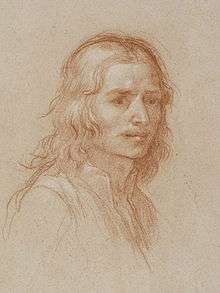Baldassare Franceschini
Baldassare Franceschini (1611 – 6 January 1689) was an Italian late Baroque painter active mainly around Florence. He was named, from Volterra the place of his birth, Il Volterrano, or (to distinguish him from Ricciarelli) Il Volterrano Giuniore, and was the son of a sculptor in alabaster.[1]

.jpg)
| Wikimedia Commons has media related to Volterrano. |
At an early age, he worked as an assistant to his father, a sculptor, and then studied with the Volterran artist Cosimo Daddi. This employment did not make full use of his talents, so the Marquese Inghirami placed him, at the age of sixteen, under the Florentine painter Matteo Rosselli. Both Francesco Furini and Lorenzo Lippi also trained with Rosselli. Within a year, he had advanced sufficiently to execute frescoes in Volterra with skilled foreshortening, followed by work for the Medici family in the Villa Petraia.[1]
In 1652, the Marchese Filippo Niccolini, planning to employ Franceschini on the frescoes for the cupola and back-wall of his chapel in Santa Croce, Florence, dispatched him to various parts of Italy to improve his style. The painter, in a tour that lasted some months, took a serious interest in the schools of Parma and Bologna, and, to some extent, in the Romano-Tuscan style of Pietro da Cortona, whose acquaintance he made in Rome. He then undertook the paintings commissioned by Niccolini.[1] These are his best works and the most well-known.
Franceschini was a better fresco painter than an artist in oils. His works in the latter medium were frequently left unfinished, although numerous examples remain; the cabinet pictures are marked by much invention.[1] He painted a scene of Elias sleeping for a wooden polyptych in the church of San Giusto in Volterra. He painted frescoes celebrating the Medici ancestry for the inner court of the Villa Petraia. The influence of his decorative style on Volterrano's work at the Villa Petraia is clear. They include a painting of the hunchbacked court jester.[2] Among his best oil paintings on a large scale is the St. John the Evangelist in the church of Santa Chiara, Volterra. One of his latest works is the fresco in the cupola of the Annunziata, Florence, which occupied him for two years towards 1683.[1]
Franceschini died of apoplexy at Volterra on 6 January 1689.[1]
His style is often distinguished by theatrical effects. Among his pupils were Massimiliano Soldani-Benzi, Antonio Franchi, Benedetto Orsi, Michelangelo Palloni, Domenico Tempesta, and Cosimo Ulivelli.[3]
Baldassare should not be confused with another eminent artist named Franceschini and of rather later date: the Cavaliere Marcantonio Franceschini (1648–1729), who was a Bolognese.
References
-

- il Gobbo Trafedi.
- Hobbes, James R. (1849). Picture collector's manual adapted to the professional man, and the amateur. T&W Boone, 29 Bond Street; Digitized by Googlebooks. p. 447.